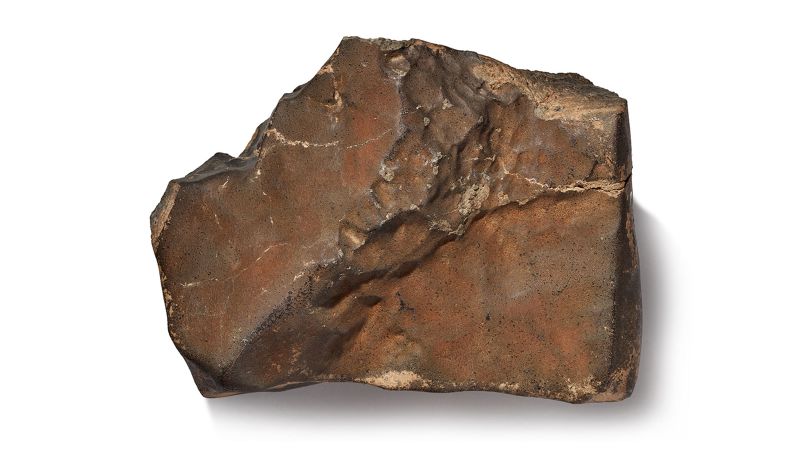In a remarkable event that has captured the attention of both space enthusiasts and collectors, a meteorite known as NWA 16788, which is recognized as the largest known piece of Mars to have ever landed on Earth, was auctioned off for an impressive $5.3 million, including taxes and fees. The auction took place at Sotheby’s in New York City on a Wednesday, where an anonymous bidder ultimately secured the rare celestial relic.
NWA 16788, weighing in at 54 pounds (approximately 24.5 kilograms), is significantly larger than most Martian meteorites, which typically consist of much smaller fragments. As detailed by Sotheby’s in a statement released on July 8, this meteorite marks a monumental find, being around 70% larger than the second largest piece of Martian rock discovered on Earth. It was unearthed in November 2023 within the remote Agadez region of Niger, a location noted for its sparse population and harsh conditions, adding to the mystique of this significant specimen.
Meteorites, by definition, are remnants that survive the journey from space through the Earth’s atmosphere, often providing valuable insights into the cosmic events of their origins. Sotheby’s describes NWA 16788 as not just a collectible but a “monumental specimen” that is also incredibly rare; scientists estimate that only about 400 Martian meteorites have ever been found on Earth. Such findings enrich scientific knowledge and understanding of the Martian environment and the cosmos as a whole.
The meteorite’s sale has sparked conversations about the intersection of science and commerce. Cassandra Hatton, vice chairman of science and natural history at Sotheby’s, emphasized the extraordinary significance of NWA 16788, highlighting its immense size and remarkable red hue that distinguishes it as a once-in-a-generation find. Hatton noted that the meteorite not only provides a tangible connection to Mars but also serves as a reminder of humanity’s enduring fascination with the red planet.
The meteorite carries a history that dates back to its origin. It is believed that the rock was ejected from the Martian surface due to an asteroid impact so intense that parts of it were transformed into glass. Furthermore, a glassy crust formed on its surface as it navigated through Earth’s atmosphere, creating a physical record of its storied journey through space.
The auctioning of such an extraordinary piece raises ethical questions among scientists and scholars. Some voices in the academic community have expressed concern that this valuable specimen could end up neglected, being stored away by a private collector rather than preserved in a museum for public education and enjoyment. Steve Brusatte, a professor at the University of Edinburgh, articulated this sentiment prior to the sale, emphasizing the importance of making such meteorites accessible for study and appreciation by future generations.
On the opposing side, experts like Julia Cartwright, a planetary scientist affiliated with the University of Leicester, argue that a market for meteorites is crucial to advancing scientific knowledge. Cartwright noted that the pursuit and trade of meteorites foster a symbiotic relationship between collectors and researchers, leading to a greater abundance of samples available for study. Despite her wish that NWA 16788 could be on public display, she pointed out that a reference sample from the meteorite has already been preserved at the Purple Mountain Observatory in China, ensuring that scientific inquiry can continue.
The conversation surrounding the sale of NWA 16788 illustrates the fine line between science, commerce, and public access to knowledge. Even though the meteorite has changed hands, Cartwright believes it will still capture scientific interest, speculating that the new owner may be keen to unlock its secrets.
As a testament to the ongoing fascination with Martian meteorites, it is noteworthy that in February 2021, another Martian rock that entraps the planet’s atmosphere sold for a noteworthy $200,000 at Sotheby’s, surpassing its pre-auction estimate significantly. This pattern demonstrates the growing interest in Martian meteorites, opening avenues for ongoing scientific exploration and the allure of space archaeology.
This event not only underlines the remarkable assets within our natural world but also sheds light on the complexities of ownership and the responsibility that comes with possessing such profound elements of humanity’s quest for knowledge about our universe. As discussions about the fate of NWA 16788 continue to unfold, the intersection of science, art, and commerce remains an intriguing arena for years to come.












